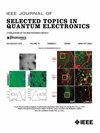Technological Approaches Addressing Reliable Output Power Limits in High Power Edge-Emitting Lasers
IF 5.1
2区 工程技术
Q1 ENGINEERING, ELECTRICAL & ELECTRONIC
IEEE Journal of Selected Topics in Quantum Electronics
Pub Date : 2025-02-03
DOI:10.1109/JSTQE.2025.3533568
引用次数: 0
Abstract
High-power edge-emitting lasers are essential in numerous applications due to their energy-efficient lasing and compact size. However, their reliable output power is often limited by catastrophic optical mirror damage (COMD), primarily caused by self-heating and elevated facet temperatures. Despite advancements in material growth, facet passivation, epitaxial design, and packaging, reliability remains a significant issue. This study introduces two innovative waveguide designs to mitigate self-heating and enhance reliable output power: a 2-section waveguide and a distributed waveguide (DWG). Both designs separate the heat-generating lasing region from the output facet by incorporating a passive section that is electrically isolated but optically connected to the laser section. The 2-section design places a long passive section near the facet, significantly reducing its temperature, while the DWG design employs periodic lasing and passive sections to enhance heat dissipation along an extended cavity length. Experimental results show that both designs effectively lower facet temperatures below the laser body temperature, enabling higher power operation. The 2-section lasers achieve COMD-free operation under high power, thereby improving reliability. These results demonstrate that advanced waveguide structures can significantly enhance the reliability of the laser output facet and pave the way for semiconductor lasers with significantly increased lifetime.解决高功率边缘发射激光器可靠输出功率限制的技术途径
高功率边缘发射激光器由于其高能效的激光和紧凑的尺寸在许多应用中是必不可少的。然而,它们可靠的输出功率往往受到灾难性光学镜面损坏(COMD)的限制,主要是由自热和表面温度升高引起的。尽管在材料生长、表面钝化、外延设计和封装方面取得了进步,但可靠性仍然是一个重要的问题。本研究介绍了两种创新的波导设计,以减轻自热和提高可靠的输出功率:两段波导和分布式波导(DWG)。这两种设计都将产生热量的激光区域与输出面分开,通过合并一个无源部分,该部分是电隔离的,但与激光部分光学连接。两段设计在面附近放置了一个长被动段,显著降低了其温度,而DWG设计采用周期性激光和被动段,以增强沿扩展腔长度的散热。实验结果表明,两种设计都能有效地将表面温度降低到低于激光体温的水平,从而实现更高的功率工作。2段激光器在高功率下实现无comd操作,从而提高可靠性。这些结果表明,先进的波导结构可以显著提高激光输出面的可靠性,为半导体激光器的寿命显著延长铺平了道路。
本文章由计算机程序翻译,如有差异,请以英文原文为准。
求助全文
约1分钟内获得全文
求助全文
来源期刊

IEEE Journal of Selected Topics in Quantum Electronics
工程技术-工程:电子与电气
CiteScore
10.60
自引率
2.00%
发文量
212
审稿时长
3 months
期刊介绍:
Papers published in the IEEE Journal of Selected Topics in Quantum Electronics fall within the broad field of science and technology of quantum electronics of a device, subsystem, or system-oriented nature. Each issue is devoted to a specific topic within this broad spectrum. Announcements of the topical areas planned for future issues, along with deadlines for receipt of manuscripts, are published in this Journal and in the IEEE Journal of Quantum Electronics. Generally, the scope of manuscripts appropriate to this Journal is the same as that for the IEEE Journal of Quantum Electronics. Manuscripts are published that report original theoretical and/or experimental research results that advance the scientific and technological base of quantum electronics devices, systems, or applications. The Journal is dedicated toward publishing research results that advance the state of the art or add to the understanding of the generation, amplification, modulation, detection, waveguiding, or propagation characteristics of coherent electromagnetic radiation having sub-millimeter and shorter wavelengths. In order to be suitable for publication in this Journal, the content of manuscripts concerned with subject-related research must have a potential impact on advancing the technological base of quantum electronic devices, systems, and/or applications. Potential authors of subject-related research have the responsibility of pointing out this potential impact. System-oriented manuscripts must be concerned with systems that perform a function previously unavailable or that outperform previously established systems that did not use quantum electronic components or concepts. Tutorial and review papers are by invitation only.
 求助内容:
求助内容: 应助结果提醒方式:
应助结果提醒方式:


